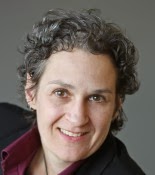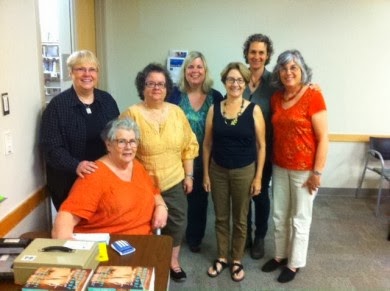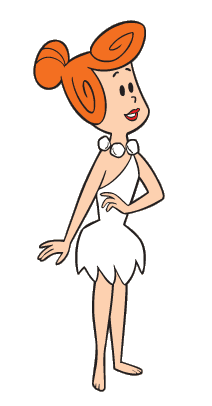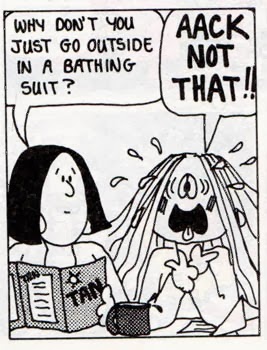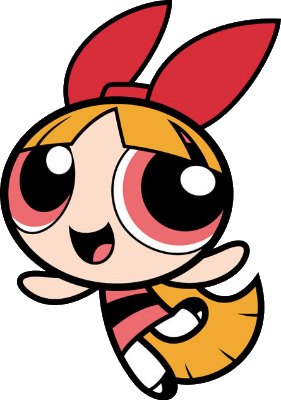HALLIE EPHRON: Amazing women are competing in this year's Winter Olympics. But there was a time... At the first Winter Olympic Games in 1924 in Chamonix, there were 11 women out of 258 competitors. Women could only compete in figure skating until 1948 when skiing was opened up to them.
![]() But since 1921, it's been women only competing for the title of Miss America. Though I haven't watched for years, my favorite part was always the talent contest. Yes, there were figure skaters. And some of the more memorable talents on display:
But since 1921, it's been women only competing for the title of Miss America. Though I haven't watched for years, my favorite part was always the talent contest. Yes, there were figure skaters. And some of the more memorable talents on display:
![]()
I could:
SUSAN ELIA MACNEAL: Oooh, I've always wanted to make homemade mayonnaise, Hallie!
I could:
![]() mountain at Alta (a few, um, years ago), preparing to go down the opposite way from the easiest way. We do not have a photo of me, splatted, soon after. So much for my skiing career.
mountain at Alta (a few, um, years ago), preparing to go down the opposite way from the easiest way. We do not have a photo of me, splatted, soon after. So much for my skiing career.
My skills. I could:
DEBORAH CROMBIE: I am so glad I didn't see the yodeling ventriloquism thing. Really. NOT even going to think about looking it up on YouTube...
You want to know about my talents? I can't sing. I can't dance. I can't play an instrument--in fact, my best pal and I got laughed out of the recital at the end of the guitar lessons we took when we were twelve... I can't blow bubbles. I can't whistle. I am not good at any sport.
I can, however, make mayonnaise. (Is there a theme here, Hallie?) I can not only cook something out of most anything in the fridge, but I do a mean clean-up. I can, like our Susan, make a smashing (no pun intended) cocktail. (Somehow I don't think they'd go for the mixologist skills in the Miss American contest...)
![]() And I can, like Hallie, type like the wind, and I can not only yodel and type (how hard can that be?) but I can type while carrying on a conversation about something completely unrelated. (This skill is honed by spouse talking to you about drains or batteries or something equally interesting while you are trying to write..)
And I can, like Hallie, type like the wind, and I can not only yodel and type (how hard can that be?) but I can type while carrying on a conversation about something completely unrelated. (This skill is honed by spouse talking to you about drains or batteries or something equally interesting while you are trying to write..)
Oh, and I'm a dandy plumber's helper.
RHYS BOWEN: Sorry, can't make mayonnaise (or I probably could, but don't)
Like Hank I can write mean parodies. For John's birthday I did "Gonna tell you a story of a man named John.." and went through his whole life.
But I'm still in stupefied shock about the danced version of the Sermon on the Mount. No, I wouldn't do that, either.
I sing quite well. I spent 10 years in ballet school but I wouldn't dance these days. I play my Celtic harp, but just for my own amusement. When I have to perform, my fingers won't work.![]()
But I do tell good jokes. I'd do a stand up comedian act as my talent, I think.
LUCY BURDETTE: I've seen Hallie type and she is very, very fast. Have not been treated to the yodeling yet...
![]() HALLIE: Be careful what you wish for.
HALLIE: Be careful what you wish for.
LUCY: I probably could place pretty high in the wearing silly costumes that match your dog's outfit competition.
The zenith of my performance career was a lipsync act to Tammy Wynette's STAND BY YOUR MAN. When the big green felt frog came out to dance with me, we brought down the house. (Believe me, that was the high point of the relationship too.)
John says, such a shame I didn't pursue skiing. I say, but I hate the cold and am afraid of heights and plunges and generally timid so, no.
Oh and PS, I make a mean birthday cake too. Just about any flavor you want...
HALLIE:So, dear readers, what's your talent, and are you ready to go for the gold?
- In 1959 Miss New York gave a vocal impersonation of Maurice Chevalier. Miss Connecticut gave a speech on fashion designing and tractor driving.
- In 1961 Miss Idaho gave a dramatic reading of "The Yellow Wallpaper" and Miss Connecticut performed a dramatic interpretation of the Sermon on the Mount.
- In 1973 Miss Florida performed a roller skate ballet to Swan Lake.
- In 1987 Miss Massachusetts did a marimba interpretation of Hava Nagila.
- In 2011's Miss Arkansas's performed a yodeling ventriloquism act.

I could:
- Type. Very fast. Like the wind. And yodel at the same time.
- Make mayonnaise. Like magic from egg yolks and oil.
- Twerk ... maybe. Or else it's the Jerk. Or maybe it's the Watusi.
SUSAN ELIA MACNEAL: Oooh, I've always wanted to make homemade mayonnaise, Hallie!
I could:
- Make flaky homemade piecrust. My grandmother taught me.
- Puppeteer (yes, my husband taught me — and Jim Henson and Frank Oz taught him, sooo.....I am not horrible.)
- Drive stick-shift in a blizzard.
My skills. I could:
- Sing along to Broadway show tunes, if it was more about knowing all the words, and less about being in tune. My big finish could be to do ALL the parts of the West Side Story "Tonight" quartet: --"A boy like that, he'd keel your brother....""Oh, no Anita, no... "ToNIGHT, tonight... ""We're gonna rock 'em tonight...)
- I can cook something out of whatever's in the fridge
- Ah, write for-the-occasion lyrics? (There seems to be a theme here.) Like: "He is the very model of a modern dad and grandpa too, He knows the finest restaurants from Panama to Katmandu..." (I did the whole thing for my Dad's birthday last year.)
DEBORAH CROMBIE: I am so glad I didn't see the yodeling ventriloquism thing. Really. NOT even going to think about looking it up on YouTube...
You want to know about my talents? I can't sing. I can't dance. I can't play an instrument--in fact, my best pal and I got laughed out of the recital at the end of the guitar lessons we took when we were twelve... I can't blow bubbles. I can't whistle. I am not good at any sport.
I can, however, make mayonnaise. (Is there a theme here, Hallie?) I can not only cook something out of most anything in the fridge, but I do a mean clean-up. I can, like our Susan, make a smashing (no pun intended) cocktail. (Somehow I don't think they'd go for the mixologist skills in the Miss American contest...)
 And I can, like Hallie, type like the wind, and I can not only yodel and type (how hard can that be?) but I can type while carrying on a conversation about something completely unrelated. (This skill is honed by spouse talking to you about drains or batteries or something equally interesting while you are trying to write..)
And I can, like Hallie, type like the wind, and I can not only yodel and type (how hard can that be?) but I can type while carrying on a conversation about something completely unrelated. (This skill is honed by spouse talking to you about drains or batteries or something equally interesting while you are trying to write..)Oh, and I'm a dandy plumber's helper.
RHYS BOWEN: Sorry, can't make mayonnaise (or I probably could, but don't)
Like Hank I can write mean parodies. For John's birthday I did "Gonna tell you a story of a man named John.." and went through his whole life.
But I'm still in stupefied shock about the danced version of the Sermon on the Mount. No, I wouldn't do that, either.
I sing quite well. I spent 10 years in ballet school but I wouldn't dance these days. I play my Celtic harp, but just for my own amusement. When I have to perform, my fingers won't work.

But I do tell good jokes. I'd do a stand up comedian act as my talent, I think.
LUCY BURDETTE: I've seen Hallie type and she is very, very fast. Have not been treated to the yodeling yet...
LUCY: I probably could place pretty high in the wearing silly costumes that match your dog's outfit competition.
The zenith of my performance career was a lipsync act to Tammy Wynette's STAND BY YOUR MAN. When the big green felt frog came out to dance with me, we brought down the house. (Believe me, that was the high point of the relationship too.)
John says, such a shame I didn't pursue skiing. I say, but I hate the cold and am afraid of heights and plunges and generally timid so, no.
Oh and PS, I make a mean birthday cake too. Just about any flavor you want...
HALLIE:So, dear readers, what's your talent, and are you ready to go for the gold?














